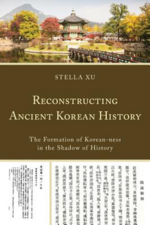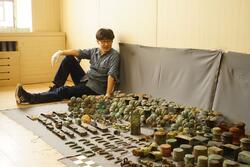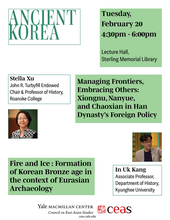Ancient Korea Lecture Series: "Managing Frontiers, Embracing Others" and "Formation of the Korean Bronze Age"
Stella Xu - John R. Turbyfill Endowed Chair & Professor of History, Roanoke College; In Uk Kang Associate Professor, Department of History, Kyunghee University
This event will consist of two lectures. A light reception with Korean food will follow from 6pm-7pm.
Managing Frontiers, Embracing Others: Xiongnu, Nanyue, and Chaoxian in Han Dynasty’s Foreign Policy. Professor Stella Xu

East Asian countries have a rich tradition of historical writing, influencing cultural traditions and national identities over time. The earliest written records on “Koreans” are found in Chinese documents from the Han dynasty (3rd century BCE-3rd century CE), serving as primary sources for early Korean history in Korea, China, and Japan. These records play a crucial role in shaping self-perception, understanding of others, and the evolution of Chinese identity, influencing foreign policy. The Han dynasty significantly impacted Chinese culture and identity, shaping foreign policy interactions with groups such as the Xiongnu, Nanyue, and Chaoxiao. The Han court delayed a military approach against the Xiongnu to amass sufficient resources. Nanyue and Chaoxian had connections to China, with the former becoming sinicized, while the latter maintained distinct identity and autonomy. Despite differences, Han policies toward the Korean peninsula were relatively successful, fostering indirect involvement and considering its people as a model of “civilizable barbarian.” Korea successfully maintained independence and autonomy, with some exceptions during the Mongol period.
Stella Xu is a John Turbyfill Endowed Chair and Professor of History at Roanoke College in Virginia, where she teaches East Asian history. She received her Ph. D at the University of California at Los Angeles. Her research topics include the history and historiography of Korea; Korean-Chinese relations; nationalism in East Asia; history, memory, and popular culture; contemporary historical disputes in East Asia; and early Korean-US relations from the late nineteenth to the early twentieth centuries. Her essays and book reviews have appeared in Korean Studies, Journal of Korean Studies, Pacific Affairs, ASIANetwork Exchange: A Journal for Asian Studies in the Liberal Arts, Women and Social Movement in the United States, 1600-2000, and Japanese Studies Association Journal. Her book, Reconstructing Ancient Korean History: The Formation of Korean-ness in the Shadow of History (Lexington Books) was published in June 2016.
Fire and Ice : Formation of the Korean Bronze age in the context of Eurasian Archaeology. Professor In Uk Kang

Korean bronzes of this period were characterized by exquisite and craftsmanship, exemplified by artifacts such as bronze mirrors featuring distinct notches. This contrasts with neighboring regions, where China produced large-scale bronze ritual vessels, Southeast Asia crafted bronze drums, and Japan developed Dotaku. The uniqueness of Korea’s bronze culture stemmed from Eurasian bronze metallurgical techniques, utilizing intense fire, and the longstanding traditions of jade and stone crafting dating back to the Neolithic era. This synthesis formed the foundation for the singular and skill-intensive nature of Korea’s bronze artifacts.
Kang, In Uk is a leading expert on the North-eastern Asia and Eurasian archaeology during bronze~early iron age. He received his bachelor’s and master’s degree from the department of Archaeology and Art History at Seoul National University. He also earned a Ph.D. from the Institute of Archaeology and Ethnology at the Siberian Branch of the Russian Academy of Sciences. He currently works as a professor in the Department of History at Kyung Hee University and director of Institute of Korean Ancient History and Archaeology (IKAA), and vice-president of Korean Central Archaeological Society. His main interest in archeology is the northern Eurasian steppe and Northeast Asia. Every year, he visits Russia, Kazakhstan, Mongolia and Central Asia to investigate new archaeological data. Currently, he is leading interdisciplinary projects on cultural exchanges between the ancient Korean Peninsula and Eurasia.

